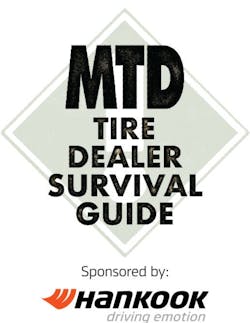How EVs will change your business model
By Craig Van Batenburg
Let me explain how I ended up writing this article, as it may set the context for those who do not know me. My relationship with tires, which are the most important part on any vehicle, starts with the fact that when I was a teenager, I only had two. They were mounted on a Honda Scrambler that I rode to high school.
Later on, I opened an independent repair shop, Van Batenburg’s Garage Inc., where I sold tires. I’m also the CEO of the Automotive Career Development Center, a leading provider of electric vehicle (EV) and hybrid vehicle training resources.
Based on my experience, I can tell you that the world around us is constantly changing. That includes the shift to EVs. (The sponsor of this article, Hankook, makes a variety of tires for EVs.)
Is your dealership ready to service these vehicles? Are you in an “EV frame of mind?” How you answer these questions will help determine your company’s future success.
I also know that as a business owner, you need data in order to make the right decisions for the future of your company.
So first, let’s look at the growth rate of EVs on a global level.
What happened during the first half of 2021 that made such a jump possible?
A newfound emphasis on EVs in Washington D.C. and many new EVs hitting the market, including the Ford Mustang Mach-E and some sleepers like the Kia Niro EV.
New EVs from the likes of Rivian, Ford (with the Ford F-150 Lightning pick-up) and other companies also will be available.
And we have seen more hybrid vehicle owners move away from fossil fuels.
There are bigger forces at play, too.
In 2019, U.S. annual energy consumption from renewable sources exceeded coal consumption for the first time since before 1885, according to the U.S. Energy Information Administration’s Monthly Energy Review.
This outcome mainly reflects the continued decline in the amount of coal used for electricity generation over the past decade, as well as growth in renewable energy, mostly from wind and solar.
Compared with 2018, coal consumption in the United States decreased nearly 15 percent and total renewable energy consumption grew by 1 percent.
The COVID-19 pandemic has not had much of an effect on EV sales, which were off less than 2 percent during its early days. Meanwhile, sales of conventional vehicles were off by 20 percent.
Many EV buyers have a sense of responsibility toward the environment. And many responded on a financial level as the cost of more EVs are within their reach.
How much of this is temporary? Most likely none, as more bad news about fires and floods will continue and the cost of EVs will decline.
Now, if you are not convinced we will be fully electric at some point in the future, you are not alone. But here’s the issue. By sitting back and doing nothing, your competition may outsmart you. What if you wait too long and the tire store down the street goes all-in and captures the EV market before you do? What then?
If you want a bigger piece of the EV business in your market, here are 10 tips to consider. (I recommend implementing one each month.)
- Meet with your entire staff and get feedback into how and what they think about EVs and EV service;
- Rent or borrow a modern EV and have it at the shop for all employees to see and drive;
- Find out if you have local competition;
- Look into training for everyone, including your service writers, salespeople and technicians;
- Look for government programs that will help with workforce development funding;
- See if a DC fast charger or a level-two charger can be installed in your parking lot;
- Check with you local utility provider for programs to help install and pay for the charger;
- Visit your local technical college or high school that has an automotive program and see what they are doing with EVs;
- Attend an EV event and talk to EV owners about what they are expect, and;
- When you roll out your EV program, make sure you are ready. Go all-in.
Let me leave you with this story. On Oct. 15, 1999, I walked into my local Honda dealership with my checkbook and told the salesperson there, “I want to buy a Honda Insight.”
She replied, “What’s an Insight?”
I told her it was a hybrid car.
Her response was, “What’s a hybrid car?”
“Will you take my money?” I then asked.
That exchange led me to open the Automotive Career Development Center, offering hands-on hybrid car classes. In 2010, we naturally added EVs to the mix. (That 2000 Honda Insight I bought is still running, by the way.)
Make sure your dealership is equipped to service EVs and sell replacement tires for these vehicles. The torque is immediate and the tire wear is, too, so keep a close eye on electric cars and trucks as they may wear tires out faster than on conventional vehicles.
I have seen many changes in our industry and you have to change with them in order to stay in the game and win. Today is a great day to start gearing up.
To learn more about Hankook, click here.
Craig Van Batenburg is the CEO of Van Batenburg’s Garage Inc. dba Automotive Career Development Center (ACDC), which is based in Worcester, Mass. A 50-year automotive service industry veteran, Van Batenburg, and his great staff provide training and equipment for auto service facilities that service—or want to service—electric and hybrid vehicles. For more information, see fixev.com, email him at [email protected] or call 508.826.4546.
This article is part of the MTD Tire Dealer Survival Guide series. As more articles are released, they can be found below:
Technician Compensation—How To Stay Competitive
How To Make the Most of Every Phone Call
